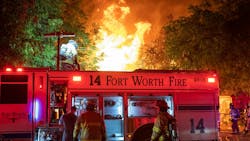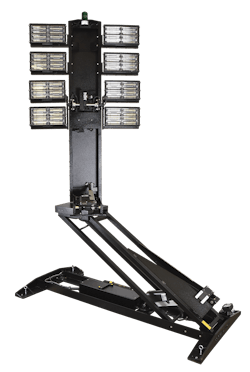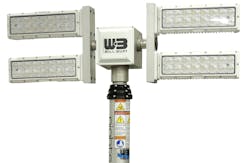What Type of Light Tower Works Best for your Fire Apparatus?
A light tower added to your apparatus can add valuable nighttime flexibility and safety to your operations. Several decisions must be made to ensure the addition works well for your department, meets your needs, and enhances your operations.
Command Light and Will-Burt are the two leading manufacturers of vehicle-mounted light towers. Command Light’s design utilizes a pantograph-type cradle assembly and Will-Burt’s is a mast-type device. Both designs, while having different operational characteristics, are well-made, durable, and have proven track records in the fire service.
Design options vary
Light towers are offered with two to eight light heads in various configurations. This will be the first of many decisions you will make regarding a light tower, and it is not as easy as you might think. Bulbs, do you choose halogen or LED fixtures? Both are available and halogen is less expensive, initially. LED light fixtures, which is everything I have seen used for lighting in the past few years, is more costly and weighs much more than halogen fixtures.
The weight can come into play with the number of light heads you want and other components, such as adding a thermal imaging camera or a video camera on your light tower. The overall weight of the desired components can affect your light tower choices in the long run.
Understanding power requirements
Power opions for light towers includes 12-volt DC, 120-volt AC and 240-volt AC. I have covered the LED power draw misunderstanding in a previous article, and it is important that you understand it. The comment, “Well, we don’t need a generator anymore because LED lights don’t draw much" is both true and false. Generally speaking, LED lights draw less power than their incandescent, strobe, or halogen predecessors. That is true. But this changes as the fixture output increases. A 28,000-lumen 120-volt AC scene light will draw approximately 2.8 amps, and the 12-volt DC version will draw approximately 21 amps, with slight amperage variations between different light manufacturers. A six-head, 12-volt DC light tower will draw roughly 126 amps, just for the lights.
The 12-volt DC electrical system in today’s fire apparatus is very capable of passing the testing protocol required in NFPA 1900: Standard for Aircraft Rescue and Firefighting Vehicles, Automotive Fire Apparatus, Wildland Fire Apparatus, and Automotive Ambulances, and its predecessor NFPA 1901: Standard for Automotive Fire Apparatus. However, something many do not understand is that scene lighting is not part of the mandated test load. You can add it to your testing specifications, even NFPA has cautionary language in NFPA 1900 Annex A: “The purchaser needs to understand, however, that there is a limit to the output capacity of an alternator system on the apparatus's engine." Depending on the alternator in your vehicle, the output at idle would be between 160 and 180 amps.
During testing, we checked the alternator output with the DOT-mandated lights (headlamps on high beam) on, emergency warning lights on, and the air conditioner on with the truck idling, at the engine's operating temperature. We found that pumpers draw between 83 and 105 amps at idle, depending on their emergency lighting package and other outfitting and that is well within the capabilities of the vehicle's 12-volt DC electrical system. Add to that the 126-amp draw of six, 28,000-lumen, 12-volt DC scene lights, and the amp draw is between 209 and 231 amps, well beyond what the electrical system can produce at idle. In that case, the high idle switch is your friend.
The apparatus will go into load-shedding fairly quickly with a high probability that the first thing you will lose is the 12-volt scene lighting. Understanding what you are asking for and, more importantly, what you are getting and how it works, and what the limitations and ramifications are, is critical. And, maybe you need that generator after all. You may not need a 10- or 12-kilowatt generator anymore, a 6- or 8-kilowatt unit may do the job.
Selecting effective light heads
To support the light towers, Command Light, Fire Research Corp., FireTech, Whelen and Will-Burt represent light fixture manufacturers in the fire market. When considering light heads, pay attention to the optics, which more than anything will dictate how well the lighting will perform. How the output of the light is utilized and directed are the most important factors. You will see two terms: raw lumens and effective lumens. Raw lumens is a mathematical calculation based on the components used in the light fixture, effective lumens usually about 30 percent less than raw lumens is a measurement of the light fixture output. Focus on making your purchasing decision based on effective lumens and optics.
When a light tower is specified, the apparatus manufacturer designs and builds and structural support into the vehicle at the light tower mounting location. This is done to properly support the weight of the light tower when it is deployed and nested and to make sure it has the needed stability to meet wind resistance requirements. If you are considering retrofitting an existing apparatus with a light tower, please keep this in mind.
Light tower functionality
Command Light and Will-Burt offer a large selection of light towers with different deployment heights, rotational capabilities, opposable lighting, aiming to light up both sides of a scene, auto-deploy and auto-stow models and both wired or wireless controls.
The Fire Apparatus Manufacturers Association publishes a wide variety of Buyer’s Guides and one of them covers light towers. I would suggest you review this prior to specifying a unit for your fire apparatus.
About the Author

Jeffrey D. Gaskin
Jeffrey D. Gaskin is president of Big Red Trucks Fire Apparatus Consultants. He is a retired captain from the Scarsdale, NY, Fire Department. Throughout his career, Gaskin has been involved in apparatus acquisitions, from needs assessment through specification-writing. He also is a fire apparatus mechanic and holds certifications from Allison Transmission, Detroit Diesel, Hale Pump, Smart Power, Spartan Chassis, Sutphen Fire Apparatus and others. Gaskin is certified by the Emergency Vehicle Technician Certification Commission in six areas: Fire Apparatus Inspection, Maintenance and Testing (F-1); Design and Performance Standards of Fire Apparatus (F-2); Fire Pumps and Accessories (F-3); Aerial Fire Apparatus (F-5); Allison Automatic Transmission (F-6); and Hydraulic Systems (F-8). He can be reached at [email protected].


